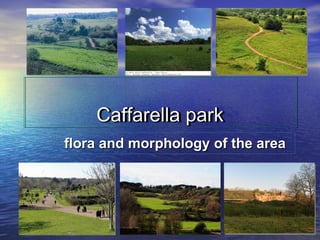Caffarella flora and fauna
- 1. Caffarella park flora and morphology of the area
- 2. This park presents some natural hills formed by the passage of a tributary of the Almone river. When the river flooded the Romans built a 6-metre viaduct to pass over the river ditch. The other hills were formed during the construction of Line A of Underground when the City Council decided to dump the excess soil in the park.
- 3. The streets leading to the park Via delle Cave: it got its name from the four tunnels under the street from which tufo and pozzolana - the local stones - were extracted. Via Latina: it was known since the Paleolitic as the street leading to the south of Italy. It was rebuilt by the Romans and got this name because it linked Lazio Vetus (all the populations of Ancient Latium). The Romans conquered these people who became Cives Romani.
- 4. The streets leading to the park Via dei Cessati Spiriti: it was used to go to the south of Italy. This street was built as an alternative to the Appian Way which was controlled by lords who asked for passage toll. Therefore Pilgrims built alternative streets in a low-lying rural area formed by the river. When pilgrims traveled along this dark street at night they where often attacked by bandits who werenŌĆÖt seen, so they were mistaken for spirits who lived along the street. In 1800 guards were set to control the street and a shrine to the Madonna was built. In this way the spirits were warded off. For this reason the street is called Via dei CESSATI SPIRITI.
- 5. FAUNA Paradise tree: Ailantus Altissima or Ailanto. ItŌĆÖs a hardwood tree imported from China to substitute the gypsum used to feed silkworms but in Italy it never happened. Black Poplar: from Latin Populus Nigra. It likes humidity and is a proof of the river presence in the past. Piazza del Popolo in Rome takes its name from this tree.
- 6. Cherry tree: from Latin Prunus Cerasiferas (carries the cherries) it has got a smooth trunk and big smooth leaves. The blossom is sacred and it is considered perfection in Japan. Robinia Pseudo Acacia: takes its name from the botanist John Robeon who discovered it . It has a large trunk with boughs and it is from north America and Canada.
- 7. Cypress:is the cemetery tree for two reasons: The roots are in contact with the ground. ItŌĆÖs tall and has a pyramidal structure which seems to put in contact earth and sky. Maple tree: from Latin Acer Mitundo, itŌĆÖs on the Canadian flag. Lime tree: it has a heart-shaped leaf and itŌĆÖs famous because honey can be produced from its blossom.
- 8. Hemlock: itŌĆÖs similar to fennel, itŌĆÖs a weed which, if eaten, frees irreversible enzymes which bring cerebral death. Holm oak: it is an evergreen from Latin Quercus Ilex. Other evergreens are Cork and Umbrella Pine tree. JudeŌĆÖs tree: from Latin Cercis Siliquastro, it takes its name from Jude who hung himself on this tree after betraying Jesus. The tree became red from his blood therefore the fruits are red.
- 9. River Almone: itŌĆÖs the river flowing from the Alban Hills. ItŌĆÖs the third river in Rome after the Aniene and the Tiber. ItŌĆÖs 20 km long and was sacred for the Romans. Near the river there is the Constantinian columbarium (tomb) . Sacred wood: according to the legend Numa Pompilio wrote the Roman laws under the inspiration of the nymph Egeria with whom he had an affair. This area became sacred for the Romans who planted many sacred oaks. This legend is narrated by Ovid. After World War II only a Holm oak remained. Now this area retains the genetic heritage of the last oak because the of this plant have been planted again.
- 10. The fountain of Egeria:is part of the heritage of Erode Atico . The legend says that the Athenian Erode Attico senior was so poor and desperate that he hit his head against a wall and he realized the wall was hollow and he found a treasure. For this reason he wrote to Nerva who told him to use and abuse the treasure. In realty Erode was a bandit who had hidden the money and his son inherited it and on he built a fountain. It was an artificial cave with a statue in the center from which the water of the God Almone sprouted, also providing the water for the octagonal pool. It was a lacus salutaris. When the Torlonia family obtained the land they built an irrigation canal from the fountain.
- 11. Tufo: is a lava stone produced by the volcano of the Alban Hills. In this volcano the lava was very dense and in order to exit it produced an explosion of gas and ash which hit all Rome with its pyroclastic flow that spread and destroyed every form of life. 10.000 years passed and the volcano woke up again causing another explosion: layers and layers of galate created tufo (compact) and pozzolana (friable).The tufo is an insulating substance.










